Thanks to tiny production quantities, exceptional quality, and increasing popularity, Burgundy tends to be expensive. In Wine Lister’s Burgundy Market Study (published in January this year), we analysed its rapidly-climbing prices. This week’s Listed blog focuses on the very tip of the Burgundy price hierarchy, with the top five by average price.
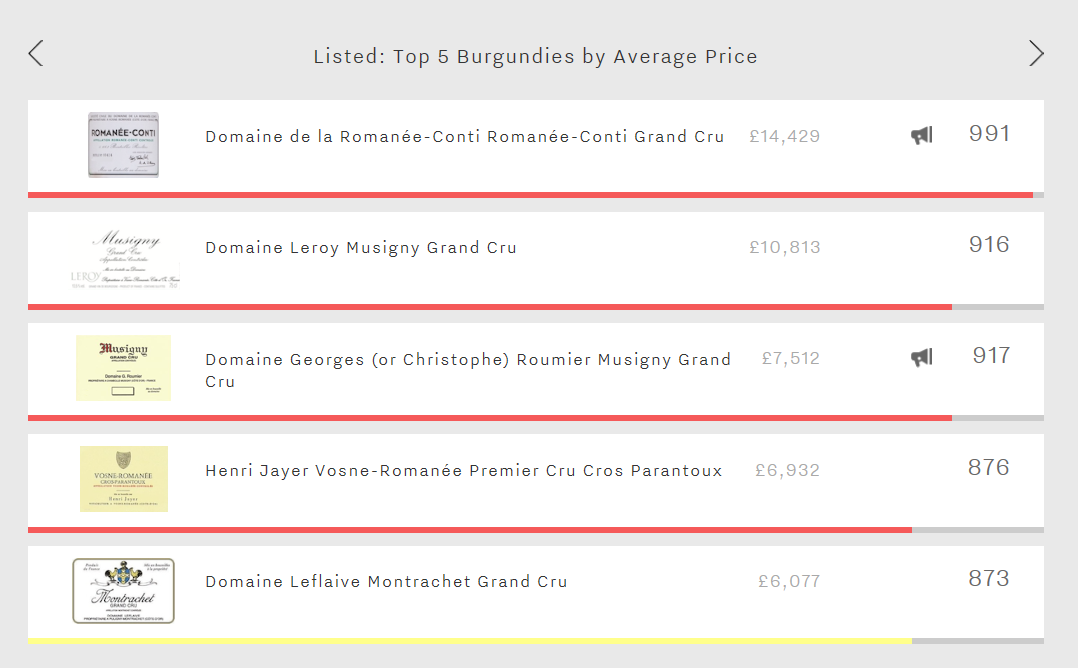
Four of this week’s top five hail from the Côte de Nuits, the first of which is, unsurprisingly, Domaine de la Romanée-Conti’s Romanée-Conti at an average price of £14,429 per bottle in-bond. The high price tag is accompanied by the best red Quality score on Wine Lister (993) and a Brand score of 989. The latter is achieved in part by being the 8th most-searched-for wine on Wine Lister (and indeed gains two and a half times as many monthly searches on Wine Searcher as the remaining wines of this week’s top five combined). Its most recent release – the 2015 vintage, receives a Quality score of 997, with Wine Lister partner critics Bettane + Desseauve and Jancis Robinson both awarding it 20/20. Even if the 2015 vintage is DRC Romanée-Conti’s best-performing in the last 15 years, its price increase of nearly 500% (from £2,925 to £17,496) since release in January is virtually incomprehensible.
In second place is one of two Musignys to feature this week. Domaine Leroy’s Musigny has an average in-bond price of £10,813 per bottle and a Quality score of 988 – just five points behind this week’s number one. Its overall Wine Lister score sits 75 points down from DRC Romanée-Conti, due to a more modest Brand score of 781. Interestingly, Leroy’s Musigny has been qualitatively more consistent over the past five releases than Wine Lister’s highest-quality red – its Quality score deviates a maximum of just one point from year to year since 2010 (compared to DRC Romanée-Conti’s maximum deviation of seven points).
Number three of this week’s top five is the second Musigny, this time from Domaine Georges Roumier. With a slightly lower price tag of £7,512 per bottle in-bond, and the second-highest Brand score of the group, Roumier is somewhat a darling of the trade – indeed, this Musigny is in the top 10% of most talked-about wines by the fine wine trade, according to Wine Lister’s Founding Member Surveys.
The last two spots are taken by wines that each stand alone among this week’s top five for their own reasons. The first, Henri Jayer’s Vosne-Romanée Cros Parantoux at £6,932 per bottle is the only Premier Cru to feature, as well as the only wine no longer in production.
Finally, Domaine Leflaive’s Montrachet Grand Cru is the only white of the group. As the most expensive white Burgundy on Wine Lister at £6,077 per bottle, it also earns white Burgundy’s highest Quality score of 985.
Part of Wine Lister’s Brand score includes a measure of prestige, achieved by analysing a wine’s presence in the world’s best restaurants. Whether a restaurant makes the cut depend on a combination of measures including the Michelin Guide, San Pellegrino 50 Best Restaurants, and World of Fine Wine Best Wine List Awards.
The chosen wine lists are then analysed to give us the breadth (how many restaurants) and depth (how many formats and/or vintages in each restaurant) of presence achieved by each wine on Wine Lister. Looking at the former criterion, the chart below shows the top 20 biggest gainers since our last blog on the subject. (Next week we will be looking at wines with the greatest increase in depth of representation.)
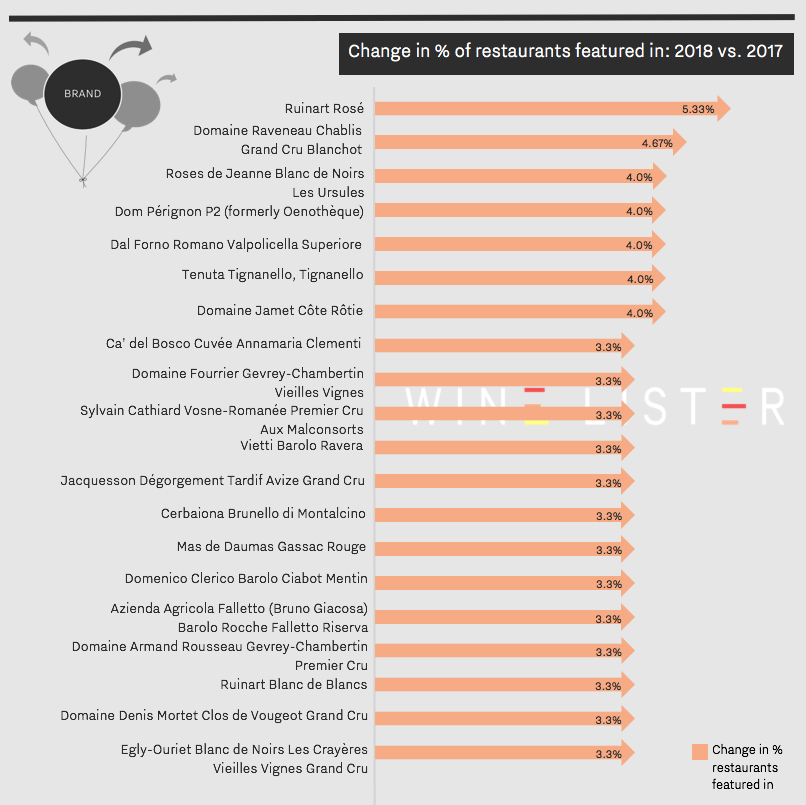
Six out of the 20 wines with the biggest increase in restaurant presence are Champagnes. Ruinart appears twice, with its NV rosé having made the greatest improvement, now appearing in 33% of the world’s best restaurants. However, the overall winner – present in more than double the number of restaurants, is Dom Pérignon’s Vintage Brut. Despite not featuring in the top 20 biggest risers above, the Champagne Brand king is now present in 69% of top restaurants worldwide, overtaking last year’s winner, Yquem.
Contrary to our last analysis on the subject, not all the biggest Champagne gainers in restaurant presence are big brands. Ruinart Rosé, Dom Pérignon P2, and Ruinart Blanc de Blancs may well fit this bill, with an average Brand score of 878, but the lesser-known three, grower Champagnes Roses de Jeanne Blanc de Noirs Les Ursules, Jacquesson Dégorgement Tardif Avize Grand Cru, and Egly-Ouriet Blanc de Noirs Les Crayères Vieilles Vignes, do not, as shown by a lower collective Brand score average of 664.
If this alone is not an indication of restaurant wine lists branching out, then perhaps the absence of Bordeaux is (indeed, a handful of Bordeaux wines with strong restaurant presence have lost a little ground since last year’s analysis). This diversification does however appear exclusive to the Old World, with no New World wines in the top 20 gainers.
Burgundy is well-represented amongst the top gainers, with one white, Raveneau’s Chablis Blanchot, and four reds: Sylvain Cathiard’s Vosne-Romanée Aux Malconsorts, Denis Mortet’s Clos de Vougeot, Armand Rousseau’s Gevrey-Chambertin, and Fourrier’s Gevrey Chambertin Vieilles Vignes.
Italy brings a show of diversity with six wines hailing from four different appellations across the 20 biggest movers. Vietti’s Barolo Ravera – one of three Barolos to feature in this list – has the lowest restaurant presence of the group (5%) and Solaia’s younger sibling, Tignanello the highest (47%).
Wine Lister periodically studies the movements of wines in and out of the four Wine Lister Indicator categories. One of these, Buzz Brands, denotes wines that achieve outstanding online popularity (measured through search rankings based on monthly searches on Wine-Searcher), and presence in the world’s best restaurants.
After analysing newcomers to the Buzz Brand segment in June, Burgundy dominates once again in our findings for October. Red Burgundy, and in particular, Gevrey-Chambertin, takes three out of the four places of this month’s new Buzz Brands.
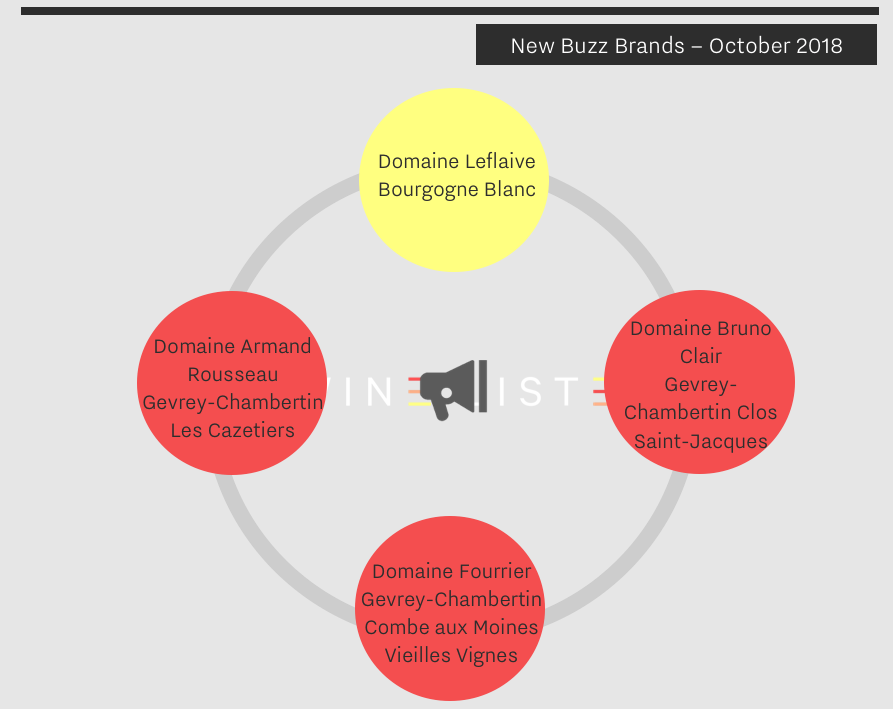
However, it is in fact the only white, Domaine Leflaive’s Bourgogne Blanc, that achieves the highest Brand score of the group at 815. All of the Domaine Leflaive wines on Wine Lister are now Buzz Brands but one – their most expensive Grand Cru, Montrachet (at £6,059 per bottle compared with £218, the average price of the rest). Indicative, maybe, of drinkers being priced out of the top wines and refocussing their interest lower down the ladder.
Perhaps it is also the sign of a good brand strategy in action, with the rising profile of the Domaine’s top wines filtering all the way down to the regional wines, via the premiers crus. The new addition of the regional offering here follows two previous new Leflaive mentions in Wine Lister’s last Buzz Brand audit (of Puligny-Montrachet Les Combettes and Meursault Sous le Dos d’Ane).
Of the three reds, two hold the same Brand score of 722, and near identical Brand profiles (see restaurant presence and search rank in the image below). The Gevrey-Chambertin Clos Saint-Jacques is the first of Bruno Clair’s wines to become a Buzz Brand. Domaine Fourrier’s Combe aux Moines Vieilles Vignes has the highest Quality score of all three new red Burgundy Buzz Brands with a score of 889. This, coupled with a slightly better Economics score helps bring it very slightly ahead for overall Wine Lister score.

Though Domaine Armand Rousseau’s Les Cazetiers is third of the Gevrey group qualitatively, it is geographically sandwiched between the first two. These wines together form a neat representation of three of the best premier cru vineyards of Gevrey-Chambertin. Incidentally, this is the last of Rousseau’s wines on Wine Lister to achieve Buzz Brand status. The domaine’s highest Brand score is won by the better-known Clos Saint-Jacques (unsurprising given that it owns roughly one third of the entire vineyard parcel) with a Brand score of 964.
Wine Lister’s first in-depth study of Burgundy published earlier this year was named “Mercury Rising” for a reason. With prices climbing more quickly than any other fine wine region, it is hard to consider the possibility of finding Burgundies of “reasonable value”. This week’s Listed blog brings you the top five Côte de Nuits by Quality score that won’t completely rupture the bank (or in other words, for under £200).
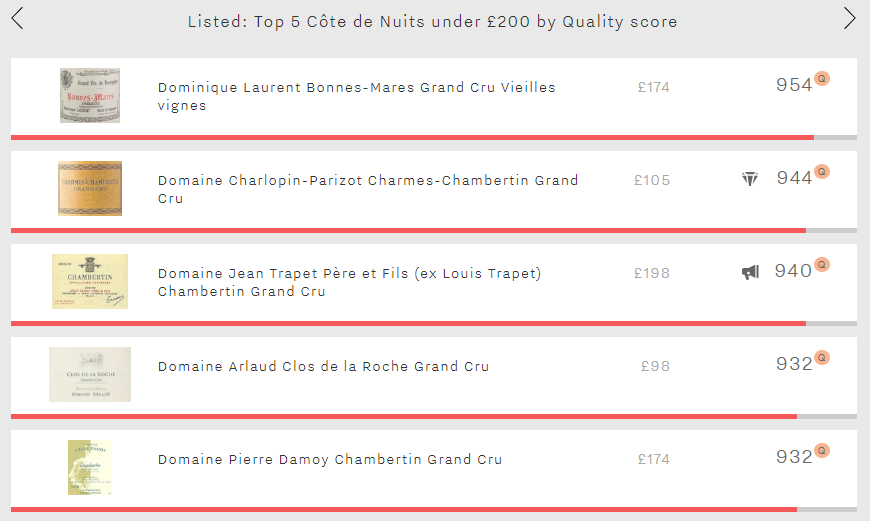
Dominique Laurent takes top spot this week with his Bonnes-Mares Vieilles Vignes, which has a Quality score of 954. Whilst this score sits comfortably amongst the highest of all Bonnes-Mares, the per bottle price of £174 does not – indeed, it is just under five times lower than the combined average price of the other eight best Bonnes-Mares on Wine Lister. Perhaps the lower price can, at least in part, be explained by its modest Brand score (531). For example, despite its Quality score sitting just one point higher, Georges Roumier’s Bonnes-Mares records a Brand score of 934, and is £1,046 more expensive.
In second place is Domaine Charlopin-Parizot’s Charmes Chambertin, with a Quality score of 944. Its high quality is not yet accompanied by an equal level of consumer recognition. With the lowest Brand score of the five (445) resulting from presence in only 2% of the world’s best restaurants and a search frequency ranking of 2,335 (of the c.4000 wines on Wine Lister), this Charmes Chambertin is a Hidden Gem (Wine Lister’s indicator that identifies under the radar wines that warrant discovery).
Domaine Jean Trapet Père et Fils’ Chambertin takes third place this week with a Quality score of 940 and just sneaking in under the £200 mark. While in third place for Quality, it has the highest overall Wine Lister score of the lot (906), thanks to its Brand (868) and Economics (896) scores. Indeed, it beats the combined average scores of the other four wines in this week’s top five in both categories by 310 and 319 points respectively.
The remaining two spots are taken by Domaine Arlaud Clos de la Roche, and Pierre Damoy Chambertin, each with a Quality score of 932. In addition to being by far the cheapest option of this week’s top five (£98 per bottle on average), Arlaud Clos de la Roche’s price is also the most stable, with volatility of just 5.7%. Conversely Damoy Chambertin’s price is the most volatile (8.7%), possibly the result of strong growth rates over both the long and short-term, having recorded a three-year compound annual growth rate of 15.6% and having added 6.5% to its price over the past six months alone.
As part of our Brand score, Wine Lister measures popularity using the three-month rolling average searches on the world’s most visited wine site, Wine-Searcher.
We have recently updated our treatment of this data to provide relative results for all 4,000+ wines on Wine Lister. Expressing each wine’s search frequency as a ranking will make it easier for our users to interpret the data. For example, Mouton is the #1 most searched-for wine of all wines on Wine Lister, according to monthly searches on Wine-Searcher.
To mark this transition, here we examine the top 50 most popular fine wines in the world.
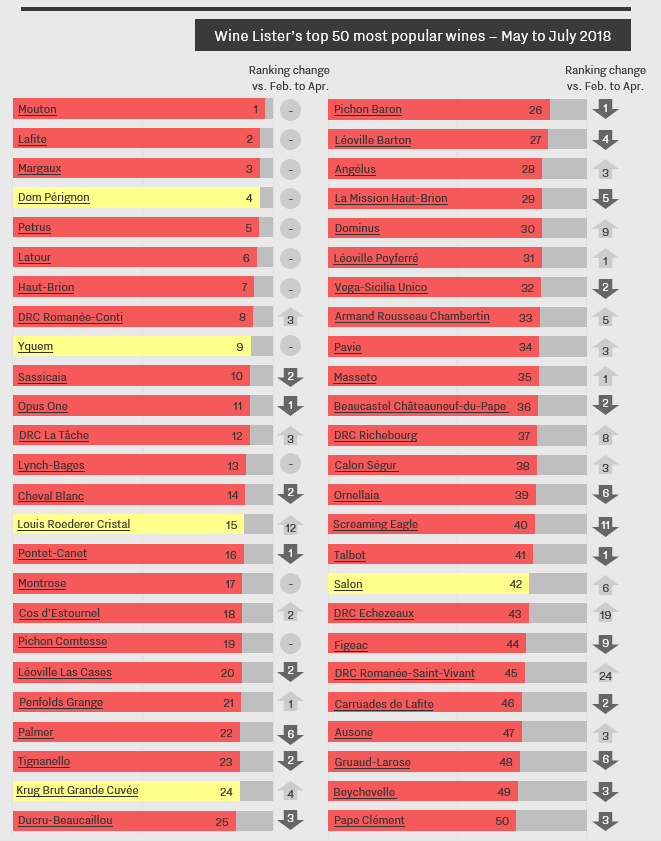
The first seven most searched-for wines for the period of May, June, and July include the five Bordeaux left bank first growths (Mouton, Lafite, Margaux, Latour, and Haut-Brion), right-bank powerhouse, Petrus, and Champagne super-brand, Dom Pérignon. It is perhaps of no surprise that these rankings remain unchanged since the previous period (February to April) .
Burgundian searches in the top 50 are dominated by Domaine de la Romanée-Conti, with Romanée-Conti, La Tâche, Echezeaux, and Romanée-Saint-Vivant all achieving better rankings versus the previous period. These four together achieve an average ranking of 30th place, and an average movement up the search ranking of 11 places.
Other than Dom Pérignon, the two remaining Champagnes featured in the top 50 most searched-for wines have moved up the rankings for May-July 2018 compared to the previous three-month period. Louis Roederer’s Cristal was up 12 places, presumably due to the release of its 2008 vintage in June. Krug’s most recent Grande Cuvée (166th edition) was released in late May, explaining its jump four spots up the rankings into 24th place.
More than half of the top 50 most popular wines are Bordeaux, with 30 wines hailing from the region. However, Bordeaux did not see the boost to their search ranking one might have expected during Bordeaux’s en primeur 2017, with one fewer of the region’s wines featuring in the top 50 than before the campaign kicked off. In fact, supporting Wine Lister’s analysis of this year’s lacklustre campaign, searches for many top Bordeaux châteaux actually fell during this period. For instance, Figeac, despite achieving Bordeaux’s 10th best Quality score of the 2017 vintage, slipped nine spots down the rankings.
This week’s Listed blog will for most be an exercise in window shopping (or perhaps lèche-vitrine might be more appropriate). Not just the eye-watering prices, but also the extreme rarity of this week’s top five – just 500 bottles of d’Auvenay’s Chevalier-Montrachet are produced each year – act as bouncers stopping all but the most fortunate from entering this exclusive Burgundian showroom. Nevertheless, we can at least vicariously get as close to Chardonnay nirvana as possible with the Côte de Beaune’s five most expensive wines.
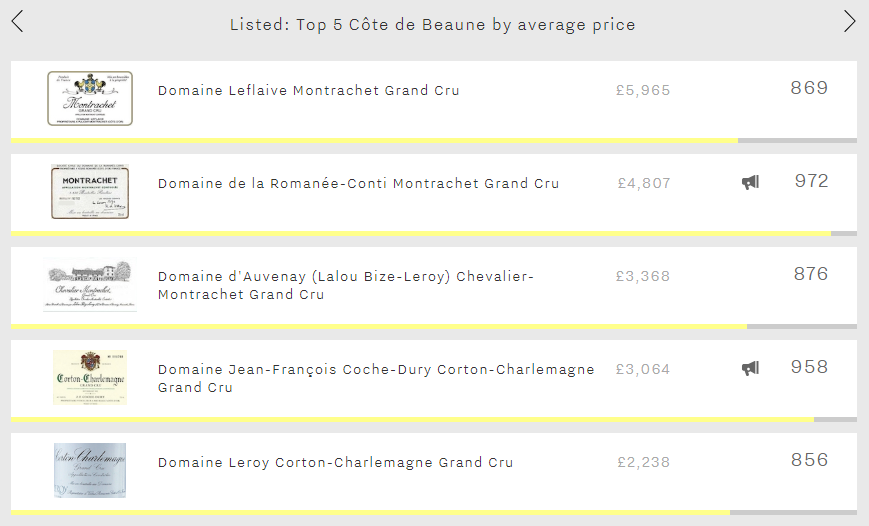
And these five really do get close to Chardonnay perfection, with a remarkable average Quality score of 975, putting them all amongst the top 15 still dry whites for Quality on Wine Lister. Perhaps reassuringly, Leflaive’s Montrachet, the Côte de Beaune’s most expensive wine, achieves the group’s best Quality score (985). 2010 was its best ever vintage, with a Quality score of 990, Jancis Robinson awarding it 19.5/20 and calling it: “[…] Not rich but gorgeous. Pale gold and obviously much fuller and deeper than Leflaive’s other grands crus. Rich yet so fresh! Nutty. Amazing concentrated fruit has already triumphed over the new oak. Very racy […]”. Interestingly, at £4,400 per bottle the 2010 is currently priced below all recent vintages other than the 2003.
Descending from the dizziest of heights, in second place is DRC’s Montrachet (£4,807). It is not just the Côte de Beaune’s overall top-scoring wine, but the best still dry white on Wine Lister (972). It is remarkably consistent across each of Wine Lister’s three rating categories, with Quality, Brand, and Economics scores of 975, 960, and 987 respectively. It is its Brand score that helps it nudge ahead in this Côte de Beaune showdown, with Coche-Dury’s Corton-Charlemagne the only one of the group to get close (924), the other three lagging c.250-290 points behind. Its brand superiority is the result of dominating both in terms of restaurant presence (visible in 26% of the world’s best establishments, comfortably above the Coche-Dury’s 19%) and online popularity (receiving 65% more searches each month than the Coche-Dury).
Whilst the Coche-Dury can’t quite match DRC’S Montrachet in the Brand or Quality categories, it does achieve the same phenomenal Economics score (987), having registered a superior three-year compound annual growth rate (25% vs 22%) and being the most-traded of the group at auction.
Lalou Bize-Leroy features twice in the list, first with d’Auvenay’s Chevalier-Montrachet (£3,368) and secondly with Domaine Leroy’s Corton-Charlemagne (£2,238). If ever there was proof of the life-altering potential of these hallowed wines, of his first taste of d’Auvenay’s Chevalier-Montrachet 1996, Wine Lister’s newest partner critic Neal Martin writes: “I took a large sip. It was like a thunderbolt hitting my senses: the tension, the complexity and intensity sent shivers down my spine. It was difficult to put down in words, yet this wine became instantly and indelibly etched onto my brain. Now I understood why oenophiles genuflected at the altar of white Burgundy”. With the d’Auvenay achieving a three-year compound annual growth rate of 45% and having added 18% to its value over the past six months alone, experiences such as Martin’s are only getting further out of reach for most.
The d’Auvenay is not alone in its soaring prices. As the chart below shows, demand for all of this week’s top five has skyrocketed over the past three years, each having added at least 62% to its value since July 2015. It seems the majority of us will have to satisfy ourselves with window-shopping for a little while longer.
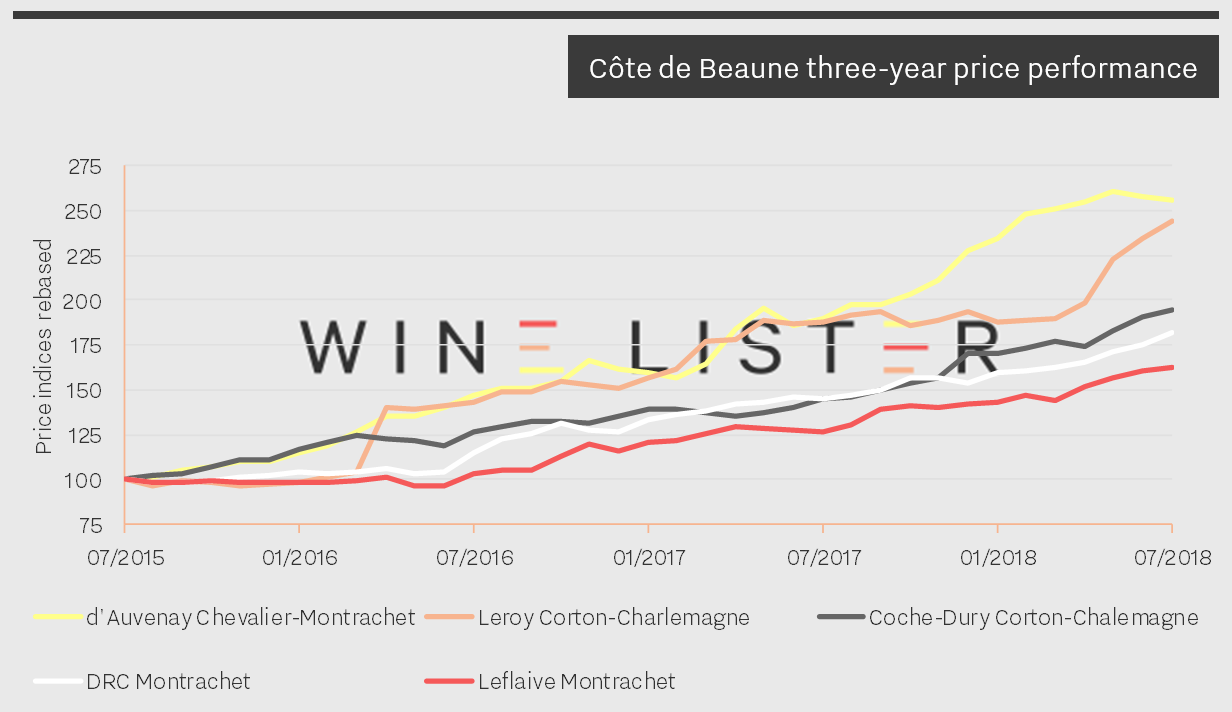
Our in-depth study of Burgundy earlier this year showed that its prices continue to rise at a faster pace than those of any other fine wine region. With such high prices and tiny availability, wine buyers seeking good value drinking wines may often find their cellar a little light on Burgundy.
However, alongside the virtually unattainable wines at the most prestigious end of the Burgundy scale, there are some Value Picks to be found.
One of four Wine Lister Indicators, Value Picks are wines with the best quality to price ratios. Wine Lister’s proprietary Value Pick algorithm allows more expensive wines with exceptional quality to shine by reducing the impact of price in calculating the ratio.
The simple answer to good value for white Burgundy is Chablis.
For exceptional value at everyday drinking level in particular, Domaine William Fèvre stands out. Seven out of the last eight vintages of the domaine’s straight Chablis are identified as Value Picks, with prices per bottle under £13 and an average Quality score of 553 (above average on Wine Lister’s 1000-point scale).
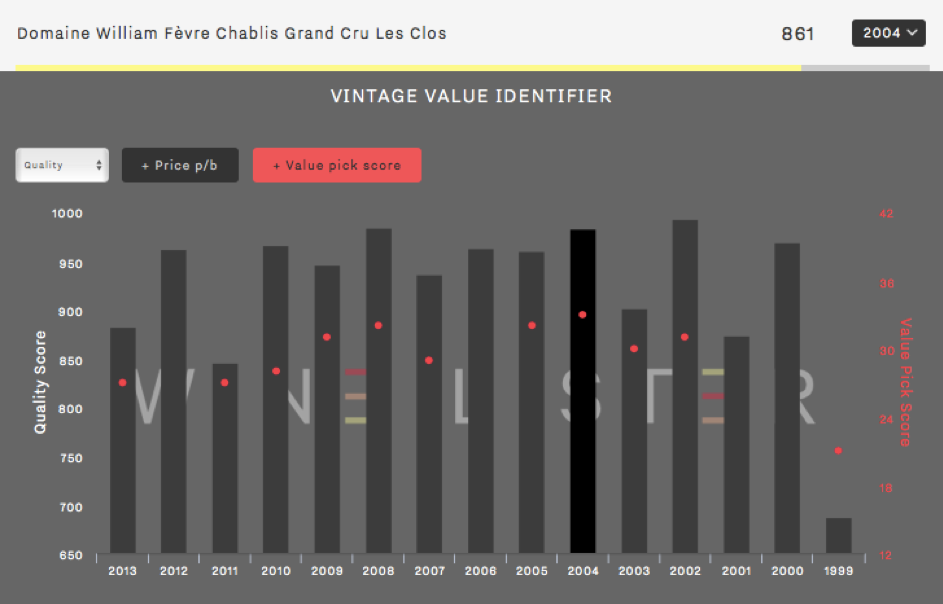
Moving up the price ladder, Domaine William Fèvre’s Chablis Grand Crus Les Clos 2004 shows exceptional value, with a price per bottle of £50 and a Quality score of 982 – shown in the Vintage Value Identifier chart above. At a comparative score (979) for white burgundy in 2004 we find Domaine Leroy’s Corton-Charlemagne Grand Cru, with a price tag 60 times higher – £3,005 per bottle.
Chablis make up all top 10 white Burgundy Value Picks.
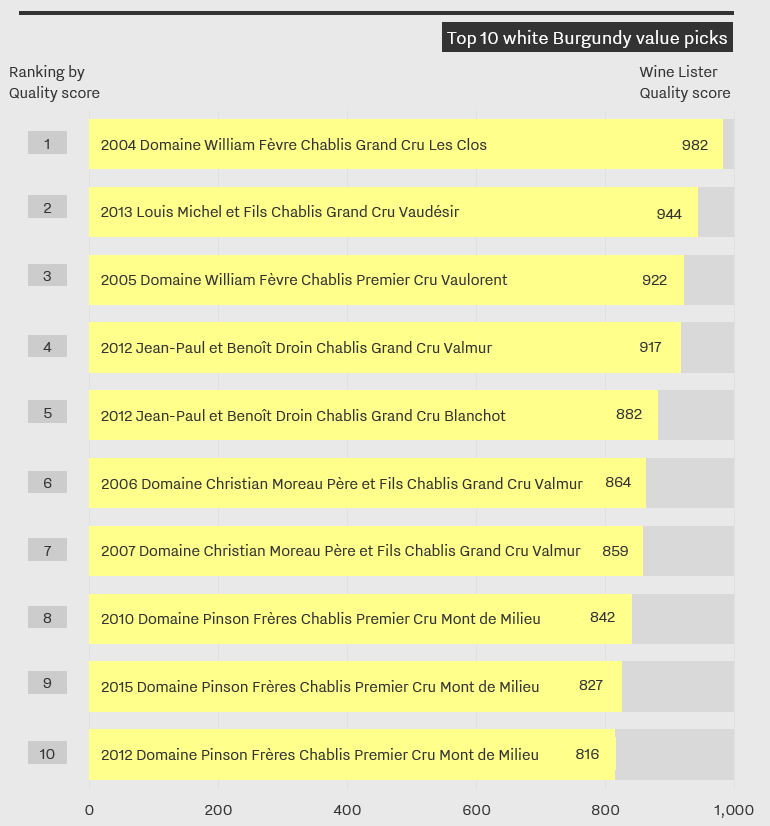
The Burgundian Value Pick with the highest Quality score is in fact a red – Domaine de la Pousse d’Or’s Volnay Premier Cru Clos de la Bousse d’Or 1995. At c.£50 per bottle and a Quality score of 983, it earns the highest Quality score for Volnay, and the third-highest for Burgundy’s 1995 vintage (after Méo-Camuzet’s Vosne Romanée Cros Parantoux and Rousseau’s Chambertin Grand Cru, priced at £1,046 and £1,448 respectively). Any lucky owners of the Clos de la Bousse d’Or 1995 should open and enjoy it now. Wine Lister partner critic, Jancis Robinson, puts its drinking window between 2006 and 2019.
Despite the annual bustle of the en primeur campaign, it is healthy to breathe some non-Bordeaux air once in a while. With Bordeaux 2017 behind us, we examine new Buzz Brands for June from contrasting locations – Burgundy and the New World. One of four Wine Lister Indicators, ‘Buzz Brands’ use Wine Lister’s bespoke algorithms to indicate trending wines found in the highest number of the world’s best restaurants, and with high online search frequency.
This month, 10 new wines have made the Buzz Brand cut, as shown in the image below.
Six Burgundian wines (four whites and two reds) become Buzz Brands in June. This aligns with results of our latest Founding Members’ survey, where Burgundy producers earned the most number of votes (50) from key members of the global fine wine trade as most likely to see the largest brand gains in the next two years.
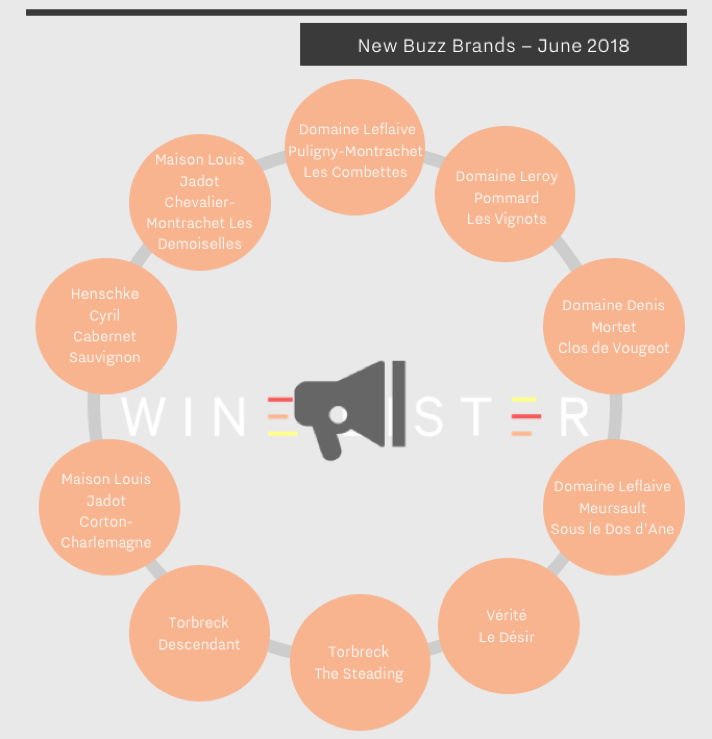
Louis Jadot and Domaine Leflaive both have two new white Buzz Brand references. Jadot’s Chevalier-Montrachet Les Demoiselles and Corton-Charlemagne have the highest Quality scores of this month’s Buzz Brand additions – 951 and 925 respectively. Domaine Leflaive proves its popularity with presence of its Puligny-Montrachet les Combettes and/or Meursault Sous le Dos d’Ane in 28 out of c.150 of the world’s best restaurants, and votes from the trade as a consistent seller (see p.23 of Wine Lister’s Bordeaux market study 2018 for more).
Of the red Burgundian Buzz Brands, the popularity of Domaine Leroy’s Pommard Les Vignots is perhaps unsurprising, given the producer’s renown, and the wine’s relative affordability (£505 per bottle) compared with Leroy’s more expensive offerings, such as its Musigny Grand Cru (£8,365 per bottle). Denis Mortet’s Clos de Vougeot is the only Côte de Nuits to feature in this month’s Buzz Brand additions.
The remaining four wines all hail from the New World – three from South Australia, and one from California. The latter, Vérité’s Le Désir, wins on all fronts with the highest Quality (949), Brand (740), and Economics (603) scores. The Quality comparison is hardly fair, given Le Désir’s price of £233, over four times higher the average of the three Australian representatives. Torbreck’s The Steading and the Descendant combined are present in 15 of the world’s best restaurants. Henschke’s Cyril Cabernet Sauvignon joins its pricier and better-known siblings, Hill of Grace Shiraz and Mount Edelstone Shiraz, as the producer’s third Buzz Brand.
You can see a full list of Wine Lister Buzz Brands here
2015 was a phenomenal vintage for reds in Burgundy. However, parts of the Côte de Beaune were affected by frost, and the quality of 2015 whites is therefore less consistent. Below we examine the top five white Burgundy 2015s by overall Wine Lister score.
Domaine Leflaive takes two of the five top spots. Its Chevalier-Montrachet has the highest overall Wine Lister score of all white Burgundies in 2015 (963). This is thanks to a Quality score of 962 (four points higher than the wine’s average across the last fifteen vintages) and an impressive Economics score of 991.
Domaine Leflaive’s Bâtard-Montrachet comes in third place. Both wines benefit from Domaine Leflaive’s position as a superstar white Burgundy brand. Indeed, five of the 10 highest white Burgundy Brand scores are held by wines from Domaine Leflaive.
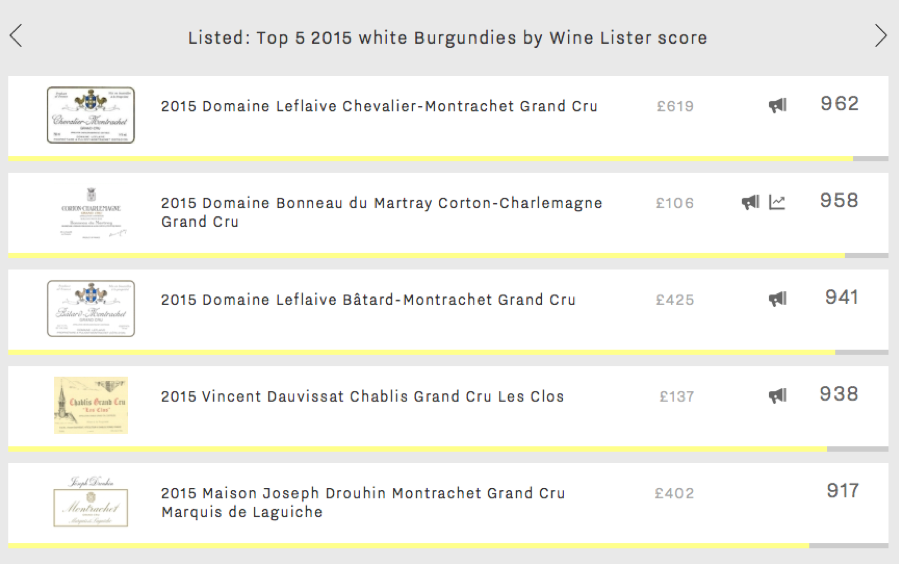
The second highest overall scorer of white Burgundy 2015 is Domaine Bonneau du Martray’s Corton-Charlemagne (958). It is both the highest Quality scorer (977, 10% above its average) and the lowest priced (£106 per bottle) of the five, presenting an interesting value opportunity. It is also to be found in 36% of the world’s top restaurants, the most prestigious count of this week’s top five.
Chablis is represented by Vincent Dauvissat’s Grand Cru Les Clos. Identified as one of only three Chablis Buzz Brands on Wine Lister, Dauvissat’s Cru Les Clos is present in 23% of the world’s top restaurants, helping it to a Brand score of 907. Its overall Wine Lister score of 938 for the 2015 vintage is completed by a Quality score of 947 and its second strongest ever Economics score of 969.
Finally, Maison Joseph Drouhin’s Montrachet Grand Cru Marquis de Laguiche has the fifth highest Wine Lister score for white Burgundy 2015s (917). Though it has the lowest global restaurant presence, it is more present than the other four wines in top restaurants in Asia.
Wine Lister uses data from our partner, Wine-Searcher, to examine wines with increasing online popularity on a monthly basis.
This month, Château Canon sees a 7% increase in search frequency for January-March 2018 from the previous period. As predicted by our Founding Members (c.50 key members of the fine wine trade), who voted Château Canon number one wine likely to gain the most brand recognition in the next two years in the 2017 Bordeaux Market study, Canon was one of the big successes of last year’s en primeur campaign. Its brand continues to go from strength to strength, with search frequency in 2017 rising 35% between January and October. It will be interesting to see whether this year’s en primeur release has the same impact on its online search frequency as the 2016 vintage.

Two cult Californian wines are among the top five for latest search frequency increases.
Scarecrow saw an increased search frequency of 52% for January-March 2018 compared to the previous period thanks to its latest release in February. The 2015 vintage is as yet unscored by Wine Lister partner critics, however the estate has seen consistent Quality scores between 996-987 since 2010.
Screaming Eagle also makes the top five wines with biggest search frequency increase this month. With 17,831 average monthly searches between January and March 2018, the increase is small relative to its already vast online popularity. Indeed, Screaming Eagle remains the number one most searched for Californian wine on Wine-Searcher.
Burgundy is represented in the top search increases by Marquis d’Angerville, whose Volnay Premier Cru Taillepieds saw double its average number of monthly searches in January-March 2018 compared with the previous period. Guillaume Angerville eschews the scrum of the January Burgundy en primeur tastings in London, preferring to showcase his new vintage each March with a small tasting and lunch – the Taillepieds obviously made an impression, and achieves its highest ever Quality score (969).
Finally, searches for Azienda Agricola Falletto’s Barolo Rocche Falletto Riserva continue to rise into March following the sad passing of Piedmont legend, Bruno Giacosa. The wine saw a bittersweet rise in popularity of 14% in December 2017-February 2018, which continues at a slightly slower pace (10%).












